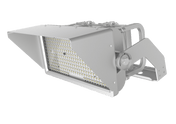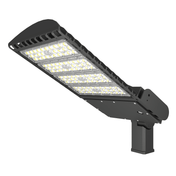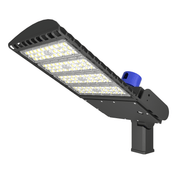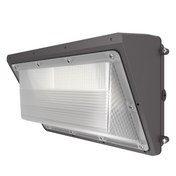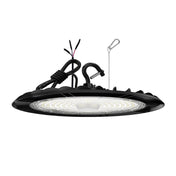Introduction
In the lighting industry, choosing the right lighting fixture is like selecting the perfect stage lighting for a performance; it directly determines the overall effect of the scene. Whether illuminating a spacious industrial plant or adding a touch of glamour to an outdoor landscape, the correct lighting choice is not only crucial for the lighting effect but is also closely linked to energy efficiency, cost control, and visual comfort. Among the many lighting fixture types, LED high-bay lights and floodlights are particularly common. Each, with its own unique advantages, plays a key role in different lighting scenarios.
LED high-bay lights are often hung high in large indoor spaces, such as industrial plants and warehouses, and logistics centers. Their powerful and even light dispels every dark corner, providing a clear visual environment for efficient work. Floodlights, on the other hand, are like magicians of light and shadow. With their adjustable illumination angles and highly concentrated beams, they skillfully outline building contours, imbue landscapes with unique artistic charm, and transform ordinary nights into captivating brilliance.
Despite their significant presence in the lighting market, many still find themselves confused and unable to choose between them. What exactly is the difference between them? Which lighting fixture is the best choice for which specific scenario? Next, let's take a deep dive into the various aspects of LED high bay lights and floodlights to unveil their mysteries and help you make informed decisions on the road to lighting selection.

1. LED High Bay Lights: The "Bearer of Light" for Large Spaces
1.1 Definition and Basic Concepts
LED high bay lights, tailor-made for tall spaces, are a powerful tool for illuminating large indoor environments. Generally speaking, they are an ideal lighting option for installations with ceilings exceeding four meters. They can be found hanging high in large factory floors, towering warehouses, and spacious gymnasiums. They are designed to provide ample, even, and high-brightness illumination in these expansive spaces, ensuring that every corner is illuminated, providing clear vision for people moving around or working.
1.2 Features and Advantages
LED high bay lights stand out in the lighting industry due to their superior performance. Firstly, they offer extremely high luminous efficacy while consuming relatively low power. Compared to traditional metal halide lamps, they offer significant energy savings of over 50%, significantly reducing energy costs for long-term operations. Their service life is also exceptionally long, reaching over 50,000 hours, reducing the hassle and cost of frequent fixture replacements and providing users with long-term, stable lighting.
LED high-bay lights offer excellent lighting performance. Their strong penetrating power ensures even illumination of the floor, even when installed at height, with virtually no noticeable shadows, providing excellent visual conditions for a variety of work scenarios. Furthermore, their durability is remarkable, with a high level of protection, effectively resisting external factors such as dust and moisture, making them suitable for a variety of complex environments.
LED high-bay lights offer exceptional flexibility in installation, allowing them to be installed using a variety of methods, including booms, chains, ceiling mounts, and brackets. They can be adjusted to suit the ceiling structure and specific needs of each location, adapting to varying floor heights and meeting diverse installation requirements.
1.3 Application Scenarios
LED high-bay lights have a wide range of applications. In the industrial sector, they are essential lighting fixtures for factory floors, providing ample light for production lines and machinery operation areas, ensuring safe and efficient work. In warehouses, they illuminate high-bay shelves, facilitating access and inventory management. They are also essential in workshop maintenance areas, where their high-brightness light assists maintenance personnel with precise work.
In commercial and public spaces, large supermarkets use LED high-bay lights to cover vast sales areas, enhancing product display and attracting customers. In stadiums and gyms, they meet the high-standard lighting requirements for competitions and training, providing a good visual environment for athletes and fitness enthusiasts. Exhibition halls and conference centers rely on their uniform illumination to create a comfortable atmosphere for presentations and communication.
In the transportation and infrastructure sector, LED high-bay lights illuminate areas such as waiting halls and aprons at airports and train stations, ensuring smooth nighttime operations. Underground parking lots use them to address the need for high-intensity coverage in areas with insufficient ceiling height. Ports and docks also rely on them for efficient illumination of outdoor work areas.
LED high-bay lights also play an important role in some specialized environments. For example, cold storage facilities, with their low-temperature-resistant design, can withstand extreme cold conditions. In flammable and explosive locations like chemical plants, explosion-proof LED high-bay lights ensure lighting safety, providing reliable support for production activities in these specialized industries.
2. Floodlights: Illuminating All-Around Wonders
2.1 Definition and Basic Concepts
Floodlights are a unique type of lighting fixture. They act as a point light source that evenly illuminates in all directions, and their illumination range can be adjusted to meet specific needs. In the lighting industry, floodlights, also known as spotlights or projection lights, cover a wide range of applications, including floodlights. They can precisely aim in any direction and feature a rugged structure that is unaffected by harsh weather conditions. They provide stable illumination, whether in scorching sun or inclement rain.
2.2 Features and Advantages
Floodlights, with their many distinctive features, occupy a significant position in the lighting market. LED floodlights offer excellent energy savings. Compared to traditional incandescent lamps, they can save approximately 75%, significantly reducing energy consumption, contributing to environmental protection while also reducing electricity costs for users.
They also offer an exceptionally long lifespan of 60,000 to 100,000 hours, meaning users don't need to frequently replace lamps for extended periods, reducing maintenance time and costs. Furthermore, they are environmentally friendly, using solid mercury as a catalyst, which emits no harmful substances and is environmentally friendly. They are also recyclable, aligning with the concept of sustainable development.
Another key feature of these floodlights is their flicker-free nature, effectively preventing eye damage caused by flicker, ensuring better vision protection for extended periods of time, whether working or entertaining under their illumination. The floodlights offer excellent color rendering and a soft, gentle glow, faithfully reproducing the colors of illuminated objects and creating a comfortable visual environment. A variety of color temperatures are available, ranging from warm white to cool white, allowing users to create a warm or bright atmosphere tailored to their needs.
Floodlights have a high ratio of visible light and high light utilization, providing ample illumination while consuming minimal energy. Furthermore, they require no preheating and can be started and restarted instantly, enabling rapid response and meeting user needs in scenarios requiring rapid illumination, such as emergency lighting and stage performances.
In terms of electrical performance, floodlights offer excellent stability and excellent electromagnetic compatibility, preventing electromagnetic interference with surrounding electronic equipment, ensuring their normal operation. They are highly adaptable in installation. Their compact and lightweight design makes them easy to conceal or install in a variety of locations, accommodating both confined corners and complex environments. Their durability also increases their durability.
2.3 Application Scenarios
Floodlights have a wide range of applications. In architectural landscapes, they are often used to illuminate individual buildings. By cleverly adjusting the illumination angle and light color, they can highlight the building's contours and features, lending it a unique charm at night. For historic buildings, floodlights can gently illuminate their exteriors, showcasing their ancient beauty without detracting from their historical charm, bringing new life to the ancient structures at night.
In commercial advertising, floodlights are a powerful tool for attracting customers' attention. They provide bright and even illumination for billboards, making advertising content clear and eye-catching even at night, effectively attracting passers-by's attention and enhancing advertising effectiveness. In commercial spaces such as shopping malls and stores, floodlights can also be used to illuminate key products, highlighting their features and advantages by focusing light and stimulating customers' desire to buy.
In cultural and entertainment events, floodlights are masters at creating atmosphere. At large-scale events such as music festivals and concerts, they can create stunning visual effects by varying color, brightness, and illumination angles, synchronizing with the rhythm of the music and providing an immersive audio-visual experience for the audience. Bars, dance halls, and other entertainment venues also frequently utilize floodlights to create unique atmospheres, ranging from romantic and warm to dynamic and exciting, catering to the needs of diverse customers and enhancing their experience.
Floodlights also play an important role in other areas. In green landscapes, they illuminate trees and flower beds, outlining the contours of plants, adding a sense of layering and visual appeal to the landscape, and bringing parks and squares to life at night. In medical and cultural facilities such as hospitals and museums, floodlights provide soft and even light, meeting lighting needs without adversely affecting patients or exhibits.

3. Key Differences: Clear at a Glance
3.1 Optical Properties
The optical properties of LED high-bay lights make them an ideal choice for vertical lighting in tall, large spaces. Their concentrated light projects downward, like a bright beam, directly illuminating the work area below, providing high-intensity, even illumination of the ground. This characteristic is particularly important in industrial plants, where workers operating machinery and performing production tasks under high-bay lighting can clearly see their workpieces, significantly improving efficiency and safety.
The optical properties of floodlights, on the other hand, give them greater flexibility in a wide range of applications. Their wide illumination range allows for adjustable angles and directions to precisely illuminate different areas. For example, in architectural landscape lighting, floodlights can illuminate buildings from different angles, highlighting their unique shapes and details and creating a unique visual effect. In stage performances, floodlights can follow the actors' movements, adjusting their illumination direction at will, adding brilliance to the performance.
3.2 Power and Brightness
LED high-bay lights typically require higher power to meet the lighting needs of large spaces, with common power ranges ranging from 50W to 400W. This high power provides bright and even lighting, ensuring ample illumination throughout the entire space. In large warehouses, high-bay lights can illuminate high shelves, making it easier for workers to find and move goods, and providing clear visibility of every corner.
Floodlights offer a wider power range, ranging from a few watts to several hundred watts, making them adaptable to a variety of scenarios. In a home garden, low-power floodlights can illuminate paths and flower beds, creating a warm atmosphere. In large plazas or stadiums, high-power floodlights provide sufficient brightness for activities and competitions. Users can flexibly select the appropriate power based on the size of the space, lighting needs, and budget.
3.3 Beam Angle
LED high-bay lights have a relatively narrow beam angle, typically between 60° and 120°. This narrow beam angle helps focus light on a specific area, reducing light scatter and improving lighting efficiency. In stadiums, high-bay lights use this narrow beam angle to precisely project light onto the playing field, providing a clear visual environment for athletes and spectators while preventing light from disrupting surrounding areas.
Floodlights offer a variety of beam angles, ranging from extremely narrow 10° to wider 180°. Narrow beam angles are suitable for projecting light over long distances and highlighting specific objects, such as illuminating the tops of tall buildings or distant sculptures. Wide beam angles are ideal for illuminating large areas, such as plazas and parking lots, providing even illumination and eliminating shadows.
3.4 Installation Height and Location
LED high-bay lights are primarily installed in locations with high ceilings, typically at heights of 4 meters or higher, with some installations reaching 10 meters or higher. Their installation location is relatively fixed, typically located at the top center of a space or along ceiling beams or other structures to ensure even illumination throughout the space. In large supermarkets, high-bay lights are installed high in the ceiling, providing ample light for shelves and aisles, allowing customers to easily select products.
Floodlights, on the other hand, offer significant flexibility in their installation location and can be installed in any direction and at any height. They can be mounted on the ground to illuminate the base of a building or landscape features such as trees and flower beds; on walls to illuminate the surface or highlight decorative features; or mounted on elevated brackets for long-range projection. In outdoor landscape lighting, floodlights can be installed in various locations as needed to create a variety of light and shadow effects.
3.5 Applicable Environments
LED high-bay lights are primarily suitable for large indoor spaces, which typically require large, high-brightness lighting to meet the needs of work and activities. Due to their high installation height, they require excellent heat dissipation and stability to ensure long-term, reliable operation. In factory workshops, high-bay lights can withstand harsh environments such as high temperatures and dust, providing stable lighting for workers. Floodlights are widely used not only indoors but also outdoors. They offer excellent waterproof and dustproof properties, typically achieving an IP65 rating or higher. They withstand rain, dust, and sandstorms, ensuring they operate reliably in a variety of harsh outdoor environments. Whether used for landscape lighting on coastal buildings or roadways in desert regions, floodlights offer excellent protection and provide reliable illumination.
4. Buying Guide: Making the Right Choice
After understanding the many differences between LED high-bay lights and floodlights, many people are concerned about how to choose the right one based on their specific needs. The following provides a detailed buying guide based on factors such as space requirements, lighting requirements, budget, brand, and quality.
4.1 Choosing Based on Space Requirements
If you need to illuminate a large space, such as an industrial plant, large warehouse, or gymnasium, with a ceiling height of 4 meters or more, LED high-bay lights are the clear choice. Designed specifically for tall spaces, they provide high-brightness, uniform vertical illumination, ensuring the entire space is fully illuminated, meeting the needs of large, high-brightness lighting.
Floodlights, on the other hand, are more suitable for small-area accent lighting or applications requiring illumination from various angles, such as architectural landscape lighting, billboard lighting, and display area lighting, due to their flexible mounting position and adjustable illumination range. In the garden, floodlights can be used to illuminate paths, flower beds, sculptures, and other areas, creating unique light and shadow effects.
4.2 Consider Lighting Needs
If you require high-brightness, uniform lighting for work or activities requiring high visual clarity, LED high-bay lighting is a better choice. In factory settings, high-bay lighting provides workers with a clear field of view, improving efficiency and safety.
Floodlights are more suitable for creating atmosphere, highlighting objects, or creating unique lighting effects. In hotel lobbies, floodlights can highlight decorative artwork or distinctive architectural elements through focused illumination, adding a unique ambiance. During stage performances, floodlights can create a variety of fantastic lighting effects tailored to the needs of the show, enhancing the audience's enjoyment.
4.3 Budget Factors
Due to their high power consumption and demanding technical requirements, LED high-bay lighting has a relatively high initial purchase cost. However, their significant energy savings and long lifespan can significantly reduce energy and maintenance costs over the long term, making them suitable for venues with strict control over long-term operating costs.
Floodlights come in a wide range of prices, from low-power, low-cost home floodlights to high-power, high-cost professional-grade floodlights. You can choose floodlights within an appropriate price range based on your budget and actual needs. For home and garden lighting, low-wattage, affordable floodlights can meet basic needs. For large commercial projects, while professional-grade floodlights may be more expensive, their excellent lighting performance and stability make them a worthwhile investment.
4.4 Brand and Quality
Choosing reputable brands and reliable products is key to ensuring lamp performance and longevity. Well-known brands typically possess advanced production technology, strict quality control systems, and comprehensive after-sales service, providing you with greater product reliability. When choosing LED high-bay lights and floodlights, you can check for relevant certifications, such as CE and RoHS, as these are key indicators of product quality and safety.
In addition, you can also learn about the actual performance and reputation of a product by reviewing user reviews and consulting with professionals. Brands with high user reviews, such as OPPLE, NVC, and Philips, enjoy a strong reputation in the market and offer guarantees regarding quality, performance, and after-sales service.
5. Real-World Case Study: Integrating Theory and Practice
5.1 Factory Workshop Lighting Retrofit
A large machinery manufacturing plant boasts a vast workshop with ceiling heights reaching 8 meters. Traditional metal halide lamps were used for lighting. However, with the expansion of production and increasing demands for a better work environment, these traditional lamps gradually began to expose numerous problems. Metal halide lamps not only consumed a lot of energy, resulting in significant monthly electricity bills, but also offered poor lighting performance and uneven light distribution, resulting in significant shadows in some corners of the workshop. This inconvenience for workers and increases the risk of errors and accidents. Furthermore, metal halide lamps had a short lifespan and required frequent replacement, which not only consumed significant manpower and material resources but also disrupted normal production.
To improve lighting conditions, the factory decided to retrofit the traditional fixtures with LED high-bay lamps. After careful planning by a professional lighting design team, they selected 200W LED high-bay lamps based on the workshop layout and work area divisions, and determined the optimal installation locations and quantity. After installation, the workshop's lighting has been significantly improved. The LED high-bay lights provide even and bright light, illuminating the entire workshop with virtually no shadows. This provides workers with a clearer view while operating machines and performing processing, significantly improving work efficiency.
In terms of energy consumption, the upgraded LED high-bay lights offer significant energy savings. Compared to traditional metal halide lamps, they reduce energy consumption by approximately 60%, significantly reducing monthly electricity bills and saving the factory considerable energy costs. Regarding maintenance costs, the long lifespan of LED high-bay lights is a significant advantage, requiring minimal replacement, saving significant annual maintenance costs, including both replacement costs and production downtime associated with these changes.
5.2 Building Landscape Lighting
A historical and cultural building, built in the early 20th century, features a unique European architectural style. Its exquisite relief carvings, towering stone columns, and arched doors and windows showcase the architectural charm of the time. To showcase the building's unique character at night and highlight its historical and cultural value, the relevant departments decided to use floodlights for landscape lighting.
The lighting design fully considered the building's structure and characteristics. Floodlights with varying power and beam angles were selected to achieve optimal lighting effects. High-power, wide-beam-angle floodlights were used on the building's facade, illuminating the entire wall from the bottom up, evenly illuminating the building's grandeur and exquisite relief details. Low-power, narrow-beam-angle floodlights were used for key areas, such as stone pillars and arched doors and windows, highlighting their unique shape and craftsmanship.
A warm yellow light color was chosen. This soft glow not only creates a warm and elegant atmosphere but also blends with the building's historical and cultural ambiance, transporting visitors back to a bygone era. Through clever lighting layout and angle adjustment, the floodlights successfully outline the building's contours, making it a striking feature of the city at night.
Since the completion of the landscape lighting project, the building has attracted numerous residents and tourists at night, enhancing the city's cultural image and contributing to the development of local tourism. The use of floodlights allows this historical and cultural building to glow with new vitality at night, becoming an important carrier of urban cultural inheritance and development.
6. Future Development Trends: Looking Ahead at the New Future of Lighting
With the rapid advancement of technology, the innovation and application of LED technology in the lighting field is accelerating, bringing endless possibilities for the future development of LED high-bay lights and floodlights.
In terms of efficiency, continued breakthroughs in LED technology will further enhance the luminous efficacy of high-bay lights and floodlights. Currently, the luminous efficacy of LED high-bay lights is quite impressive, but it is expected to reach even higher levels in the future, for example, from the current 150-180 lumens per watt to 200 lumens per watt or even higher. This means that at the same wattage, high-bay lights can provide brighter and more adequate lighting, further reducing energy consumption and saving businesses and users more on electricity bills. Floodlights will also benefit from improved luminous efficacy, achieving more efficient lighting while operating at lower wattage, reducing energy waste and being more energy-efficient and environmentally friendly.
Intelligent control will become a key development direction for LED high-bay lights and floodlights in the future. Through deep integration with technologies such as the Internet of Things and artificial intelligence, high-bay lights and floodlights will possess even more intelligent functions. They use sensors to sense ambient light, human activity, and other information in real time, automatically adjusting brightness, color, and illumination angle. In factory workshops, high-bay lights can automatically reduce brightness to save energy when no one is active in a certain area, and quickly return to normal brightness when someone enters. Intelligently controlled floodlights can achieve a wider range of lighting effects tailored to different scenarios and needs. In architectural landscape lighting, intelligent control systems can automatically switch between different lighting scenes based on time, season, or special holidays, creating a unique and captivating atmosphere.
Multifunctional integration is also a major future trend. LED high-bay lights and floodlights will no longer be limited to lighting functions; they will integrate more functional modules to meet the diverse needs of different scenarios. High-bay lights may be integrated with smoke alarms, temperature sensors, and other devices, providing not only illumination but also timely alarms in the event of a fire and monitoring ambient temperature, providing greater assurance for safe production. Floodlights may also be integrated with cameras and wireless communication modules, enabling monitoring and data transmission while providing illumination. In some public places, floodlights with integrated cameras can monitor the surrounding environment in real time, facilitating security management. Floodlights with integrated wireless communication modules can also connect with other smart devices for more intelligent control and management.
Furthermore, as people's interest in healthy and comfortable lighting continues to grow, future LED high-bay lights and floodlights will place greater emphasis on improving light quality. They will provide a spectrum closer to natural light, reduce the harmful effects of blue light, and improve the color rendering index, making the colors of illuminated objects more realistic and natural, creating a healthier and more comfortable lighting environment.
In the future, driven by technological innovation, LED high-bay lights and floodlights will continue to develop and improve, bringing higher-quality, efficient, and intelligent lighting experiences to our lives and work, illuminating our future.
7. Conclusion
LED high-bay lights and floodlights are two major lighting fixture types in the lighting industry, each with unique optical characteristics, power and brightness performance, beam angles, installation requirements, and applicable environments. LED high-bay lights, with their high brightness and uniform vertical illumination, are an ideal choice for tall indoor spaces. They play a vital role in industrial plants, warehouses, gymnasiums, and other places, providing ample, clear light for work and activities. Floodlights, with their flexible mounting locations, adjustable illumination range, and diverse beam angle options, are widely used in architectural landscape lighting, commercial advertising, cultural and entertainment events, and other fields. Through ingenious lighting design, they can create a variety of unique light and shadow effects, adding artistic charm to any environment.
When choosing a lighting fixture, we shouldn't simply base our decision on its features; we must also carefully consider the specific needs. In terms of spatial requirements, LED high-bay lights are preferred for tall and large spaces, while floodlights are suitable for smaller, accent lighting or multi-angle lighting scenarios. Regarding lighting requirements, high-bay lights are preferred for high-brightness, evenly lit scenes, while floodlights are more suitable for creating atmosphere and highlighting objects. Budget is also a factor. While LED high-bay lights have a higher initial cost, they offer long-term energy savings and low maintenance costs. Floodlights also come in a wide price range, allowing for flexible selection based on budget. Brand and quality are crucial, with reputable brands and high-quality products offering superior performance and after-sales service.
Through real-world case studies, we can more intuitively demonstrate the outstanding performance of LED high-bay lights and floodlights in different scenarios, and how, through appropriate application, they can bring significant benefits and value to users. In the future, with the continuous advancement of technology, LED high-bay lights and floodlights will achieve even greater breakthroughs in efficiency improvement, intelligent control, multi-functional integration, and optimized light quality, creating a higher-quality, smarter, and healthier lighting environment.
When choosing between LED high-bay lights and floodlights, we encourage everyone to fully understand their differences and make an informed decision based on their individual needs. Let the right lamps become your right-hand assistant to illuminate your life, work and environment, adding more brightness and beauty to our world.


